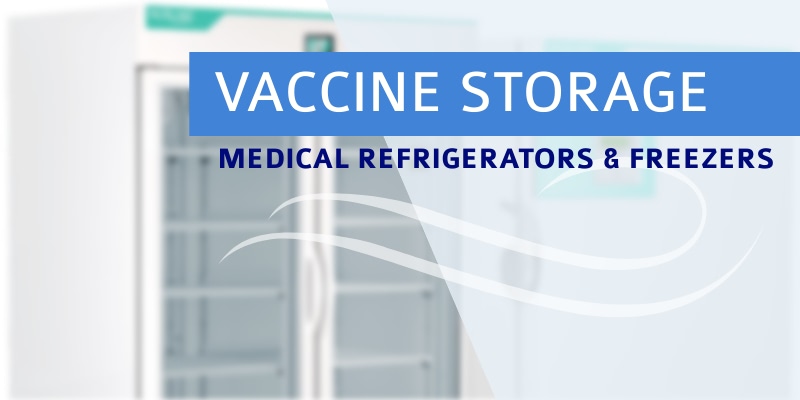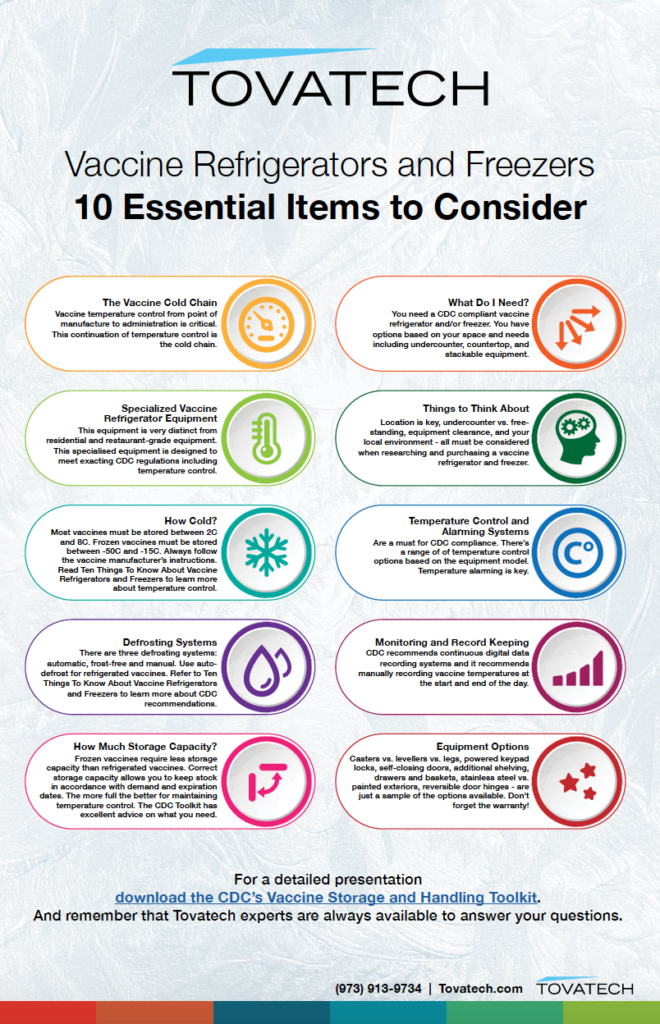
Specification Guidelines for Medical Refrigerators
Medical refrigerators – also called laboratory and scientific refrigerators – employed across healthcare and research facilities can be broadly classified into three categories:
- Medical refrigerators – operating at temperatures between 35⁰ and 46⁰F (2⁰ and 8⁰C)
- Medical freezers – operating at a temperature range of -4⁰ to -31⁰F (-20⁰ to -35⁰C)
- Ultra low temperature freezers with a temperature range of -58⁰ to -123⁰F (-50⁰ to -86⁰C)
Temperatures shown are examples. Temperature capability is indicated on manufacturers’ spec sheets. What’s important for you is selecting a medical refrigerator system that conforms to guidelines established by government and professional associations.
Note that household or commercial-grade units are not recommended for medical refrigeration as they are unable, for example, to maintain temperatures to exacting standards.
Costs of Improper Storage
As one example, improper storage, malfunctioning equipment, human error, and power failures annually cause thousands of dollars in losses due to compromised vaccines. Costs include vaccine replacement along with the inconvenience of locating and revaccinating people who received compromised vaccine.
Tissues, forensic samples, and other biological specimens in long-term storage may be irreplaceable if equipment or procedures fail.
This post provides information that can help you develop your specification guidelines for medical refrigerators and freezers. It concludes with a check list of features to look for.
Medical Refrigerators for Vaccine Storage
The CDC’s 2023 Vaccine Storage and Handling Toolkit states that maintaining a cold chain throughout the entire vaccine supply chain is critical to the safety and security of vaccines. The cold chain begins with the cold storage unit at the manufacturing plant and extends through the transport and delivery of the vaccine and proper storage at the provider facility. It ends with administering vaccine to the patient.
Additionally, the CDC stresses in its Vaccine Storage and Handling Pink Book that manufacturers, distributors, public health staff, and health care providers share responsibility to ensure the vaccine cold chain is maintained from the time vaccines are manufactured until they are administered.
Medical Refrigerators for Blood Storage
The Code of Federal Regulations CFR 640.4 (h) provides guidelines for blood storage immediately after collection.
Unless it is to be further processed, blood storage should be at temperatures between 33.8⁰ – 42.8⁰F (1⁰ and 6⁰C). Blood storage refrigerators should be designed in such a way to maintain these tight temperature tolerances. Added useful capabilities are alerting personnel in the event of temperature excursions and automatically recording the unit’s internal temperature for record keeping.
Medical Refrigerators for Medical Devices
According to the Food and Drug Administration, “Many medical devices require specific storage conditions. The manufacturer’s instructions in the product labeling will explain specific needs for refrigeration, freezing, or controlled room temperature.”
The report notes that “The majority of reagents used for laboratory testing are temperature sensitive, with most requiring routine refrigeration.”
“A small subset of materials require freezer, or below freezer-level conditions (ranging from freezing to 70 degrees below freezing).”
The FDA document further details the importance of proper storage temperatures for dialysis, disinfectants and other medical products and procedures.
Refrigeration for Biological and Biomedical Sample Preservation
An Applied Clinical Trials article on sample banking notes “To assure sample integrity, the appropriate storage of biological samples is one of the key challenges in sample collections.”
“Biological sample must be stored in fully validated storage units at different temperatures and conditions depending on the biological samples and ranging from controlled room temperature storage, cold storage, ultra low-temperature storage, and vapor phase liquid nitrogen storage.”
“Sample temperatures must be monitored, and the sample storage facility supported by multiple backup systems and an inventory tracking system.”
“Related to this, an article in LabCompare states “Preservation of biological samples such as tissues, plasma and forensic and pathology specimens relies on maintaining proper storage temperatures and on the type of sample and analysis to be done.”
“Sample temperatures must be monitored, and facilities supported by backup systems and tracking. As per the FDA, frozen samples should be kept at –28 to –18 °C and refrigerated samples between 2 and 8 °C; ambient samples should be protected from heat and moisture.”
Another Resource for Medical Refrigeration Good Manufacturing Practice
The United States Pharmacopeia publishes a document providing guidance on storing, distributing, and shipping Pharmacopeial preparations. While echoing other references in this post, the USP document includes physical and temperature challenges regarding refrigeration along with information on materials used in shipping products.
A Medical Refrigeration Check List
Purpose-built refrigeration equipment is preferred because it is designed to maintain tight temperature control as well as providing other safeguards.
Here we provide suggestions on what to look for when purchasing a medical refrigerator or freezer. These recommendations are in no particular order; all have importance when it comes to safeguarding their contents.
Storage Capacity
Medical refrigerators and freezers are available in sizes ranging from countertop and undercounter units to multiple-door units. If possible, avoid units with on-door storage.
Specify the size you need. And what is that? If you have a moving inventory typical of healthcare facilities keep your stock current in accordance with needs and expiration dates.
Full refrigerators and freezers (without crowding) do a better job of maintaining temperature. We suggest you allow 2 to 3 inches between the contents and the side and back walls of the unit.
Replace removed stock with cold water bottles or freezer packs. Food and beverage containers are not substitutes for water bottles and freezer packs.
For more on this refer to our post on how to determine refrigeration capacity requirements.
Defrosting Options
Many manufacturers offer automatic defrost, frost free and manual defrost options in their product lines. What is the difference?
Defrosting cycles remove ice buildup on coils and in freezers also remove ice buildup on walls.
Auto-defrost refrigerators have fans to move chilled air throughout the unit in order to create and maintain uniform internal temperatures. During the defrost cycle compressors turn off but the fans continue to run to remove frost accumulation from the coils.
Auto-defrost freezers periodically activate a heater to melt ice accumulated on the coils, and this results in thermal cycling inside the cabinet.
Manual defrost freezers are better able to maintain temperature uniformity than auto-defrost models, but a thick layer of ice will affect a unit’s ability to efficiently maintain temperatures and will eventually cause failure. Therefore, regular defrosting is recommended but you must have a backup freezer pre-set at the correct temperature for temporary sample storage while defrosting the primary unit.
For more on how systems work, check our scientific refrigerator learning center.
A Note on Low Temperature Freezers
Low temperature and ultra-low temperature upright and chest freezers are generally selected for long-term storage. For a detailed description see our post on when and how to specify an ultra-low freezer.
Temperature Control and Display Systems
For storage applications where a certain degree of latitude is permitted for proper storage temperature, less precise control may be acceptable. Examples are dial-type thermostats with letters or numbers ranging from cold, colder, coldest.
For tighter temperature control, the more precise programmable logic control is offered and is a recommended choice for maintaining minimum temperature drift. As examples, Corepoint® Scientific refrigerators and freezers available from Tovatech are equipped with digital LED display microprocessor temperature controllers.
Internal temperatures should reflect the temperature of the contents as opposed to the temperature of internal air, which can change quickly when doors are opened. This is accomplished by product temperature sensors.
Alarming and Recording Systems
Temperature alarming is an absolutely critical feature when storing valuable vaccines, pharmaceuticals and biological specimens. Alarming systems are standard on many medical refrigerators and freezers.
If your refrigeration equipment does not have built-in alarming systems, it can be fitted with optional digital temperature alarms.
Temperature recording is a very important SOP component for storage of temperature-sensitive products. Record keeping is simplified thanks to the ability of temperature sensors to collect data within the units for validation purposes. Procedures for monitoring and accessing data vary based on the system. Some examples:
- Calibrated temperature monitoring devices with a Certificate of Traceability and Calibration Testing (also known as Report of Calibration)
- A USB device to collect temperature data for quick transfer to a computer
- Calibrated digital data loggers
- Web-based record-keeping systems
Note that while these systems are extremely important lab personnel should manually record temperatures at the beginning and end of the day.
Have a “Plan B” for Valuable Medical Refrigeration Storage
Substantial losses are incurred when scientific refrigeration systems fail due to equipment malfunction or in the event of a power system failure.
On-site backup generators are an important component of proper storage practices.
Generators should be checked on a regular basis to ensure availability if and when the need arises. If your facility is not equipped with backup power or an alternate on-site capability for protecting samples, you should establish a plan to quickly relocate the samples to an alternate storage facility.
Please contact Tovatech’s refrigeration specialists for additional information on selecting medical refrigerators and freezers to meet your scientific refrigeration needs.

